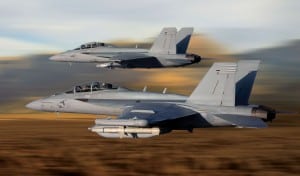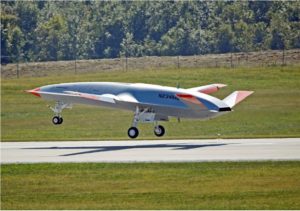A Navy official said the replacement for the F/A-18E/F Super Hornet fleet will likely be a manned fighter working with unmanned systems under the overall Next Generation Air Dominance (NGAD) program while the service is pushing for the future airwing to ultimately reach over 50 percent unmanned aircraft.
The service is looking at the Next-Generation Air Dominance (NGAD) program as a family of systems with the F/A-XX platform as the centerpiece, Rear Adm. Gregory Harris, Director of the Air Warfare Division at the Office of Chief of Naval Operations (OPNAV N98), said Tuesday during a virtual Navy League breakfast event.

Harris said while the decision on whether F/A-XX will be manned or unmanned is undecided yet, it will be “the fixed-wing portion of the Next-Gen Air Dominance family of systems.”
“In the next probably two to three years we’ll have a better idea whether the replacement for the F/A-18E and F will be manned or unmanned. I would believe it will most likely be manned, but I’m open to the other aspects of it. But the family of systems will definitely include manned and unmanned systems.”
Harris emphasized the Navy version of NGAD is more than just the successor to the Super Hornet.
“We believe that as manned-unmanned teaming comes online, we will integrate those aspects of manned and unmanned teaming into that,” he said.
“Whether that – we euphemistically refer to it as our little buddy – is an adjunct air-to-air platform, an adjunct [electronic warfare] platform, discussion of could it be an adjunct advanced early warning platform. We’ll have to replace the E-2D [Advanced Hawkeye] at some point in the future, so as we look to what replaces that.” Harris continued.
Harris noted NGAD is being divided into two increments. Increment one is the replacement for the Super Hornets while increment two will replace the EA-18G Growler.
He said the Navy is going through the study portions of what increment two will be but “we expect that that family of systems will be a combination of manned and unmanned.”
Earlier this month, Vice Adm. James Kilby, Deputy Chief of Naval Operations for Warfighting Requirements and Capabilities, told a House Armed Services Committee panel that the Navy thinks it can reach upward of 40 percent of the aircraft in the airwing of the future to be unmanned before moving beyond that (Defense Daily, March 18).
Harris expanded on that point Tuesday.
“Right now, notionally looking at driving towards an airwing that has a 40-60 unmanned-manned split and over time shift that to a 60-40 unmanned-manned split. So try to drive an airwing that is at least 50 percent or more unmanned over time.”
He admitted that will be dependent on success seen with the Boeing [BA] MQ-25A Stingray unmanned carrier-based tanker aircraft “and our ability to truly learn to operate around an aircraft carrier and safely execute that both on the flight deck and then airborne.”
Harris said the overall decision on a manned vs. unmanned Super Hornet replacement will come through the concept refinement phase, which is where the service is now.
“That concept refinement phase and the teams that we have with our prime air vehicle vendors will start to advise what’s in the realm of possible. Has autonomy and artificial intelligence matured enough to be able to put a system inside an unmanned platform that has to go execute air-to-air warfare?”
However, Harris said, “I think air to air warfare is one of, if not the most, complex ones to try to put into autonomy.”
He argued this is because unmanned systems will have to be able to sense all the things an aviator learns for air combat maneuvering and then react to them. “That will take some time.”

In contrast, “having an unmanned platform out there as an adjunct missile carrier I see as not a step too far too soon. I could have that unmanned friend – I typically say a flying Dorito chip when I’m thinking about it.”
“An unmanned system with missiles, I can clearly in my mind envision a way to say – fly a defense combat spread, shoot on this target, and I will squeeze the trigger or I will just execute – enable that unmanned platform to shoot the designated target. That doesn’t stretch beyond my realm of imagination,” Harris added.
Harris noted the Navy is working closely with its Air Force counterparts on their own NGAD program.
He said both services’ NGAD platforms will likely have different “outer mold lines” based on the different surface needs, “but a lot of the internal mission systems will be similar and open mission system architecture and our government referenced design that will enable us to use best of breed.”
Harris used the example that over time the capability or sustainability performance of a particular radar sensor may not be worth it.
“With that open mission system architecture you have an ability to more rapidly replace that without getting into vendor lock. We’ve seen vendor lock create problems for us before, we firmly believe that competition will give us better reliability, lower sustainment costs, and lower the overall costs.”
Relatedly, Harris said he thinks companies interested in competing for NGAD should look at different ways to team with different partners.
“Our industry primes get very comfortable with the folks they’ve worked with the past. Some of that’s worked out very well for us, other times it may not have worked as well as you would have liked and I just recommend that they broaden their view and look at as many of those folks we can to team.”
Harris said they think expanding partnerships could also enable smaller companies to be able to work in niche markets that they may then become successful in.
Boeing is the prime contractor for the Super Hornet and Growler aircraft.